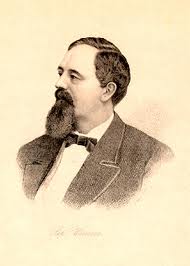Annotation:Zara Jig: Difference between revisions
Appearance
Created page with "=='''Back to [[{{BASEPAGENAME}}]]'''== ---- <p><font face="garamond, serif" size="4"> '''ZARA JIG.''' American, "Sand" Jig (2/4 time). A Major (1st part) & E Major (2nd part)...." |
m Text replacement - "garamond, serif" to "sans-serif" |
||
| (3 intermediate revisions by 2 users not shown) | |||
| Line 1: | Line 1: | ||
=='''Back to [[{{BASEPAGENAME}}]]'''== | =='''Back to [[{{BASEPAGENAME}}]]'''== | ||
---- | ---- | ||
<p><font face=" | [[File:winner2.jpg|200px|thumb|right|]] | ||
'''ZARA JIG.''' American, "Sand" | <p><font face="sans-serif" size="4"> | ||
'''ZARA JIG.''' American, "Sand Jig" (2/4 time). A Major (1st part) & E Major (2nd part). Standard tuning (fiddle). AABB. The composition is credited to Al Bauer in Septimus Winner's (1827–1902) collection. A 'sand jig' is a kind of duple-time syncopated banjo tune often played as an accompaniment to dancers who used a sanded floor to facilitate brush steps. | |||
<br> | <br> | ||
<br> | <br> | ||
</font></p> | </font></p> | ||
<p><font face=" | [[File:winner.jpg|200px|thumb|left|Septimus Winner]] | ||
<p><font face="sans-serif" size="4"> | |||
''Source for notated version'': | ''Source for notated version'': | ||
<br> | <br> | ||
<br> | <br> | ||
</font></p> | </font></p> | ||
<p><font face=" | <p><font face="sans-serif" size="4"> | ||
''Printed sources'': Ford ('''Traditional Music | ''Printed sources'': | ||
Ford ('''Traditional Music of America'''), 1940; p. 99. | |||
Winner ('''New American School for the Banjo'''), 1883; p. 38 ([http://contentdm6.hamilton.edu/cdm/compoundobject/collection/spe-ban/id/3159/rec/4]). | |||
<br> | <br> | ||
<br> | <br> | ||
</font></p> | </font></p> | ||
<p><font face=" | <p><font face="sans-serif" size="4"> | ||
''Recorded sources'': <font color=teal></font> | ''Recorded sources'': <font color=teal></font> | ||
<br> | <br> | ||
<br> | <br> | ||
</font></p> | </font></p> | ||
<p><font face=" | <p><font face="sans-serif" size="4"> | ||
See also listing at:<br> | See also listing at:<br> | ||
Hear/see the tune played on fretless banjo by Tim Twiss on youtube.com [https://www.youtube.com/watch?v=wM9RSOFC5Oc]<br> | Hear/see the tune played on fretless banjo by Tim Twiss on youtube.com [https://www.youtube.com/watch?v=wM9RSOFC5Oc]<br> | ||
</font></p> | </font></p> | ||
<br> | <br> | ||
<br> | <br style="clear:both"/> | ||
---- | ---- | ||
=='''Back to [[{{BASEPAGENAME}}]]'''== | =='''Back to [[{{BASEPAGENAME}}]]'''== | ||
Latest revision as of 14:48, 6 May 2019
Back to Zara Jig

ZARA JIG. American, "Sand Jig" (2/4 time). A Major (1st part) & E Major (2nd part). Standard tuning (fiddle). AABB. The composition is credited to Al Bauer in Septimus Winner's (1827–1902) collection. A 'sand jig' is a kind of duple-time syncopated banjo tune often played as an accompaniment to dancers who used a sanded floor to facilitate brush steps.

Source for notated version:
Printed sources:
Ford (Traditional Music of America), 1940; p. 99.
Winner (New American School for the Banjo), 1883; p. 38 ([1]).
Recorded sources:
See also listing at:
Hear/see the tune played on fretless banjo by Tim Twiss on youtube.com [2]
